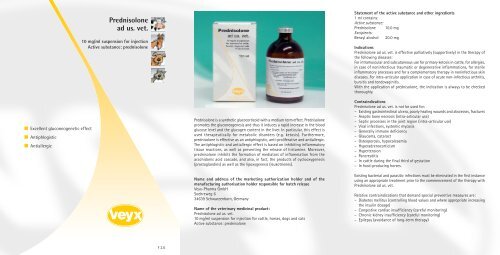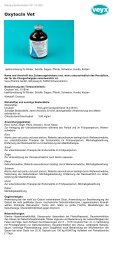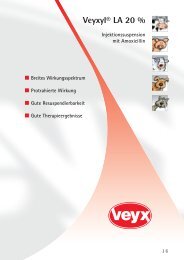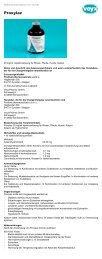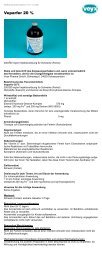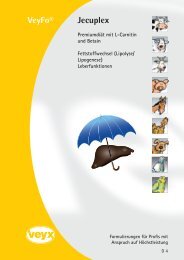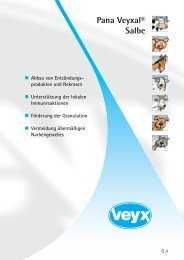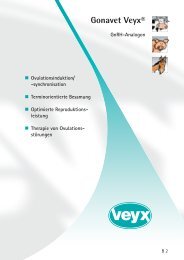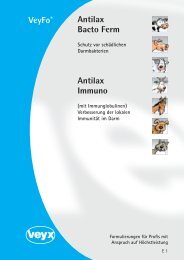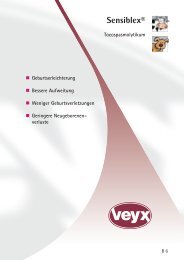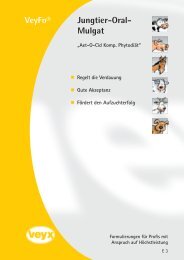Prednisolone ad us. vet. - Veyx-Pharma GmbH
Prednisolone ad us. vet. - Veyx-Pharma GmbH
Prednisolone ad us. vet. - Veyx-Pharma GmbH
You also want an ePaper? Increase the reach of your titles
YUMPU automatically turns print PDFs into web optimized ePapers that Google loves.
� Excellent gluconeogenetic effect<br />
� Antiphlogistic<br />
� Antiallergic<br />
<strong>Prednisolone</strong><br />
<strong>ad</strong> <strong>us</strong>. <strong>vet</strong>.<br />
10 mg/ml s<strong>us</strong>pension for injection<br />
Active substance: prednisolone<br />
F 2.6<br />
<strong>Prednisolone</strong> is a synthetic glucocorticoid with a medium term effect. <strong>Prednisolone</strong><br />
promotes the gluconeogenesis and th<strong>us</strong> it induces a rapid increase in the blood<br />
glucose level and the glycogen content in the liver. In particular, this effect is<br />
<strong>us</strong>ed therapeutically for metabolic disorders (e.g. ketosis). Furthermore,<br />
prednisolone is effective as an antiphlogistic, anti-proliferative and antiallergic.<br />
The antiphlogistic and antiallergic effect is based on inhibiting inflammatory<br />
tissue reactions, as well as preventing the release of histamine. Moreover,<br />
prednisolone inhibits the formation of mediators of inflammation from the<br />
arachidonic acid casc<strong>ad</strong>e, and also, in fact, the products of cyclooxygenesis<br />
(prostaglandins) as well as the lipoxygenesis (leukotrienes).<br />
Name and <strong>ad</strong>dress of the marketing authorization holder and of the<br />
manufacturing authorisation holder responsible for batch release<br />
<strong>Veyx</strong>-<strong>Pharma</strong> <strong>GmbH</strong><br />
Soehreweg 6<br />
34639 Schwarzenborn, Germany<br />
Name of the <strong>vet</strong>erinary medicinal product:<br />
<strong>Prednisolone</strong> <strong>ad</strong> <strong>us</strong>. <strong>vet</strong>.<br />
10 mg/ml s<strong>us</strong>pension for injection for cattle, horses, dogs and cats<br />
Active substance: prednisolone<br />
Statement of the active substance and other ingredients<br />
1 ml contains:<br />
Active substance:<br />
<strong>Prednisolone</strong> 10.0 mg<br />
Excipients:<br />
Benzyl alcohol 20.0 mg<br />
Indications<br />
<strong>Prednisolone</strong> <strong>ad</strong> <strong>us</strong>. <strong>vet</strong>. is effective palliatively (supportively) in the therapy of<br />
the following diseases:<br />
For intram<strong>us</strong>cular and subcutaneo<strong>us</strong> <strong>us</strong>e for primary ketosis in cattle, for allergies,<br />
in case of noninfectio<strong>us</strong> traumatic or degenerative inflammations, for sterile<br />
inflammatory processes and for a complementary therapy in noninfectio<strong>us</strong> skin<br />
diseases. For intra-articular application in case of acute non-infectio<strong>us</strong> arthritis,<br />
bursitis and tendovaginitis.<br />
With the application of prednisolone, the indication is always to be checked<br />
thoroughly.<br />
Contraindications<br />
<strong>Prednisolone</strong> <strong>ad</strong> <strong>us</strong>. <strong>vet</strong>. is not be <strong>us</strong>ed for:<br />
– Existing gastrointestinal ulcera, poorly healing wounds and abscesses, fractures<br />
– Aseptic bone necrosis (intra-articular <strong>us</strong>e)<br />
– Septic processes in the joint region (intra-articular <strong>us</strong>e)<br />
– Viral infections, systemic mycosis<br />
– Generally immune deficiency<br />
– Glaucoma, cataract<br />
– Osteoporosis, hypocalcaemia<br />
– Hyper<strong>ad</strong>renocorticism<br />
– Hypertension<br />
– Pancreatitis<br />
– In cattle during the final third of gestation<br />
– In food-producing horses.<br />
Existing bacterial and parasitic infections m<strong>us</strong>t be eliminated in the first instance<br />
<strong>us</strong>ing an appropriate treatment prior to the commencement of the therapy with<br />
<strong>Prednisolone</strong> <strong>ad</strong> <strong>us</strong>. <strong>vet</strong>.<br />
Relative contraindications that demand special preventive measures are:<br />
– Diabetes mellit<strong>us</strong> (controlling blood values and where appropriate increasing<br />
the insulin dosage)<br />
– Congestive cardiac insufficiency (careful monitoring)<br />
– Chronic kidney insufficiency (careful monitoring)<br />
– Epilepsy (avoidance of long-term therapy)
The application of glucocorticoids should only occur after strict positioning<br />
of the indication in:<br />
– Growing animals and old animals<br />
– Suckling animals<br />
– Gestating animals, beca<strong>us</strong>e of the in<strong>ad</strong>equately clarified potentially<br />
teratogenic effects of prednisolone<br />
– Equines, as glucocorticoid induced laminitis can occur as a complication.<br />
With vaccinations, an appropriate time interval should be maintained for a<br />
therapy with glucocorticoids. An active immunisation should not be carried<br />
out during and for 2 weeks after a glucocorticoid therapy. The development<br />
of an <strong>ad</strong>equate immunity through a protective vaccination that was carried<br />
out up to 8 weeks prior to the commencement of therapy can be affected.<br />
Adverse reactions<br />
– ACTH suppression, reversible dis<strong>us</strong>e atrophy of the <strong>ad</strong>renal cortex<br />
– Immunosuppression with elevated risk of infection and negative outcomes<br />
for the course of infections<br />
– Delayed healing of wounds and bones, osteoporosis, arthropathy, m<strong>us</strong>cular<br />
atrophy, retarded growth with disturbed bone growth and damage of the<br />
bone matrix in young animals<br />
– Diabetogenic effect with reduced glucose tolerance, steroid induced diabetes<br />
mellit<strong>us</strong> and worsening of an existing diabetes mellit<strong>us</strong><br />
– C<strong>us</strong>hing-syndrome<br />
– Pancreatitis<br />
– Degr<strong>ad</strong>ation of the myoclonic threshold, manifestation of a latent epilepsy,<br />
euphoriant effect, states of excitement, spor<strong>ad</strong>ic depression in cats, in<br />
dogs – spor<strong>ad</strong>ic depression and aggressivity<br />
– Atrophoderma<br />
– Glaucoma, cataract<br />
– Polydipsia, polyphagia, polyuria<br />
– Gastrointestinal ulcers<br />
– Reversible hepatopathy<br />
– Thrombotic tendency<br />
– Hypertension<br />
– Sodium retention with oedema formation, hypokaliaemia, hypocalcaemia<br />
– Induction of parturition in cattle in the final third of gestation, subsequently<br />
increased retained placenta<br />
– Temporary reduction in milk yield in cattle<br />
– Laminitis in horses<br />
If you notice any serio<strong>us</strong> effects or other effects not mentioned in this leaflet,<br />
please inform your <strong>vet</strong>erinary surgeon or pharmacist.<br />
Target species<br />
Horse, cattle, dog, cat<br />
Dosage for each species, routes and method of <strong>ad</strong>ministration<br />
For intram<strong>us</strong>cular, subcutaneo<strong>us</strong> and intra-articular injection.<br />
For single application.<br />
Horse: 0.5 to 1.0 mg prednisolone per kg body weight i.m./s.c.,<br />
equivalent to<br />
0.05 to 0.1 ml <strong>Prednisolone</strong> <strong>ad</strong> <strong>us</strong>. <strong>vet</strong>. per kg body weight.<br />
5 to 250 mg prednisolone per joint intra-articular,<br />
equivalent to<br />
0.5 to 25 ml <strong>Prednisolone</strong> <strong>ad</strong> <strong>us</strong>. <strong>vet</strong>. per joint.<br />
Cattle: 0.2 to 0.5 mg prednisolone per kg body weight i.m./s.c.,<br />
equivalent to<br />
0.02 to 0.05 ml <strong>Prednisolone</strong> <strong>ad</strong> <strong>us</strong>. <strong>vet</strong>. per kg body weight<br />
5 to 250 mg prednisolone per joint intra-articular, equivalent to<br />
0.5 to 25 ml <strong>Prednisolone</strong> <strong>ad</strong> <strong>us</strong>. <strong>vet</strong>. per joint.<br />
Dog, Cat: 0.2 to 0.5 mg prednisolone per kg body weight i.m./s.c.,<br />
equivalent to<br />
0.02 to 0.05 ml <strong>Prednisolone</strong> <strong>ad</strong> <strong>us</strong>. <strong>vet</strong>. per kg body weight<br />
5 to 20 mg prednisolone per joint intra-articular, equivalent to<br />
0.5 to 2 ml <strong>Prednisolone</strong> <strong>ad</strong> <strong>us</strong>. <strong>vet</strong>. per joint.<br />
Advice on correct <strong>ad</strong>ministration<br />
Care should be taken with intra-articular application that the maximum<br />
systemic dose based on the weight of the animal is not exceeded.<br />
Shake before <strong>us</strong>e.<br />
Withdrawal period<br />
Cattle: Edible tissues: 18 days, Milk: 1 day<br />
Horse: Not applicable<br />
In horses intended for human consumption, following the final treatment a<br />
withdrawal period of 6 months for meat, offal and milk is to be <strong>ad</strong>hered to.<br />
There is a compulsory documentation requirement for pharmaceutical<br />
treatments in the Equine passport (Part III B).<br />
In horses not intended for human consumption, the requirements for a<br />
withdrawal period do not apply and recording in the equine passport is<br />
voluntary (Part III B).<br />
Special storage precautions<br />
Do not store above 25 °C. Keep the vial in the outer carton.<br />
Do not <strong>us</strong>e after the expiry date which is stated on the label and box.<br />
Once broached, <strong>us</strong>e within 28 days.<br />
Special warnings<br />
Special precautions for <strong>us</strong>e in animals:<br />
A severe progression of infections can occur under glucocorticoid therapy,<br />
such as <strong>Prednisolone</strong> <strong>ad</strong> <strong>us</strong>. <strong>vet</strong>. The <strong>vet</strong>erinarian responsible for the therapy<br />
is to be notified where there is an outbreak of infections.<br />
Special precautions to be taken by the person <strong>ad</strong>ministering the <strong>vet</strong>erinary<br />
medicinal product to animals:<br />
Not applicable<br />
Interaction with other medicaments and other forms of interaction:<br />
Mixing with other medicaments is to be avoided beca<strong>us</strong>e of possible<br />
incompatibility.<br />
– Decreased cardiac glycoside tolerance following potassium deficiency<br />
– Intensified potassium losses with simultaneo<strong>us</strong> giving of thiazide and loop<br />
diuretics.<br />
– Increased risk of gastrointestinal ulcers and gastrointestinal bleeding with<br />
simultaneo<strong>us</strong> treatment of nonsteroidal antiphlogistics<br />
– Decreased efficacy of insulin<br />
– Decreased glucocorticoid efficacy with the giving of enzyme inducing<br />
medicaments (e.g. barbiturates)<br />
– Increased intraocular pressure in a combined treatment with anticholinergics<br />
– Decreased efficacy of anticoagulants<br />
– Suppression of skin reactions with intracutaneo<strong>us</strong> allergy tests<br />
Special precautions for the disposal of un<strong>us</strong>ed or waste materials, if any:<br />
Medicines should not be disposed of via wastewater or ho<strong>us</strong>ehold waste. Ask<br />
your <strong>vet</strong>erinary surgeon how to dispose of medicines no longer required.<br />
These measures should help to protect the environment.<br />
Other information<br />
Vial (100 ml)<br />
To be supplied only on <strong>vet</strong>erinary prescription<br />
<strong>Veyx</strong>-<strong>Pharma</strong> is GMP, DIN EN ISO 9001: 2000 and QS certified.<br />
<strong>Veyx</strong>-<strong>Pharma</strong> <strong>GmbH</strong> · Soehreweg 6 · 34639 Schwarzenborn · Germany<br />
Phone 0049 5686 9986-0 · Fax 0049 5686 1489 · E-Mail zentrale@veyx.de<br />
www.veyx.de<br />
06/2009


